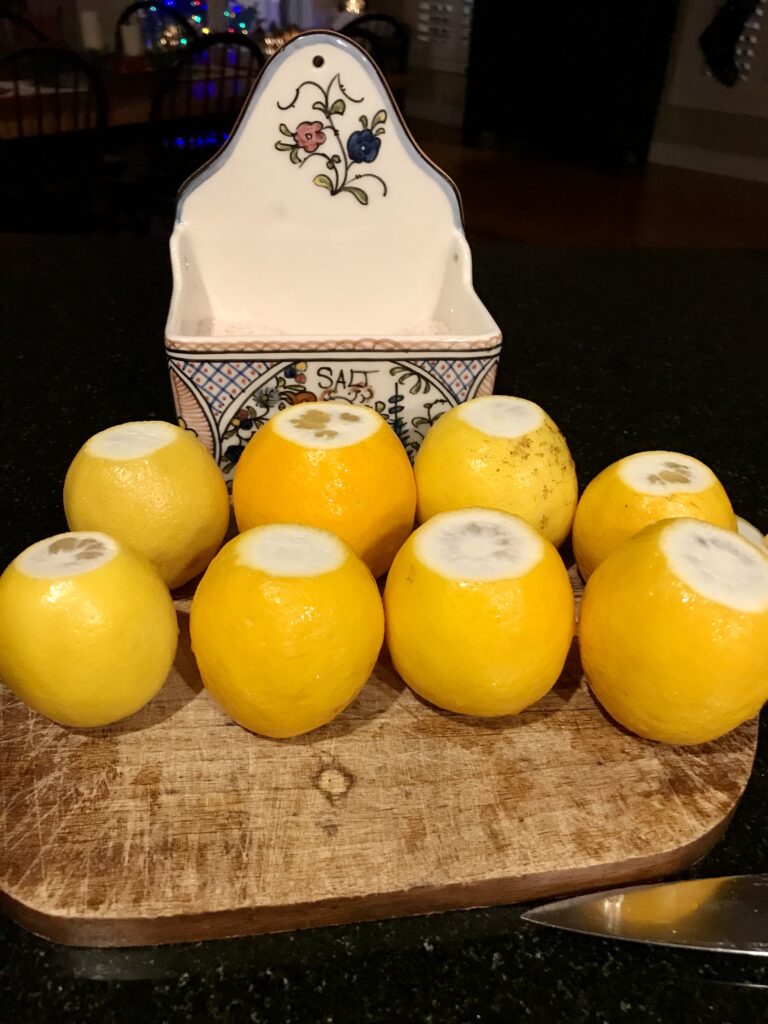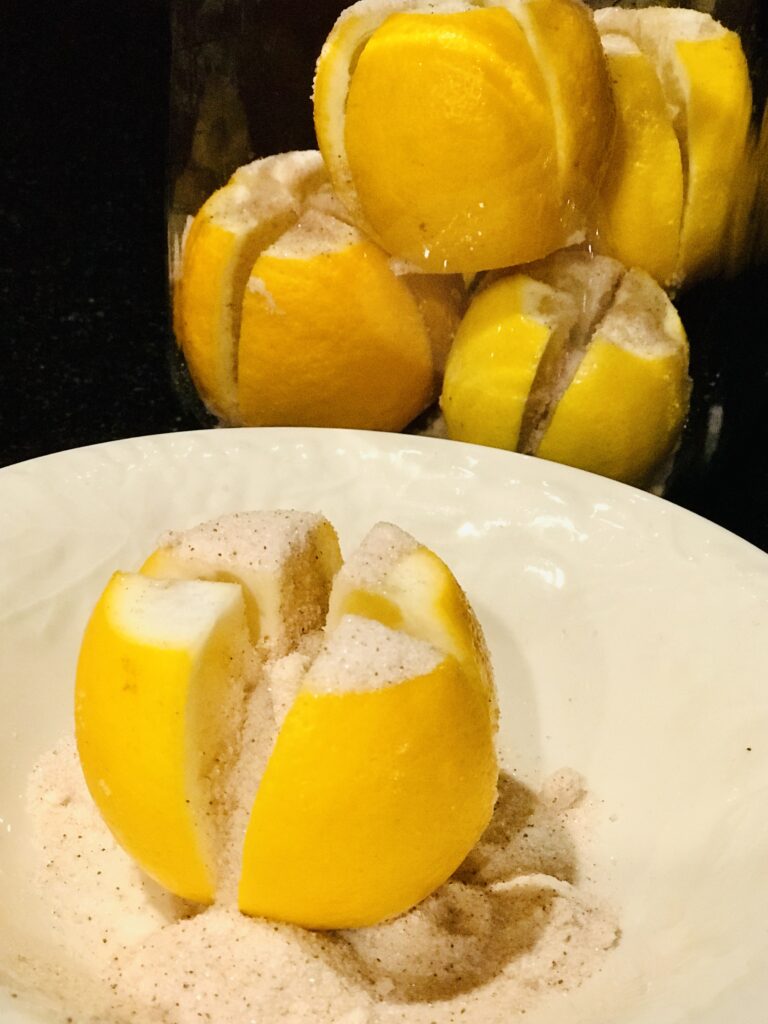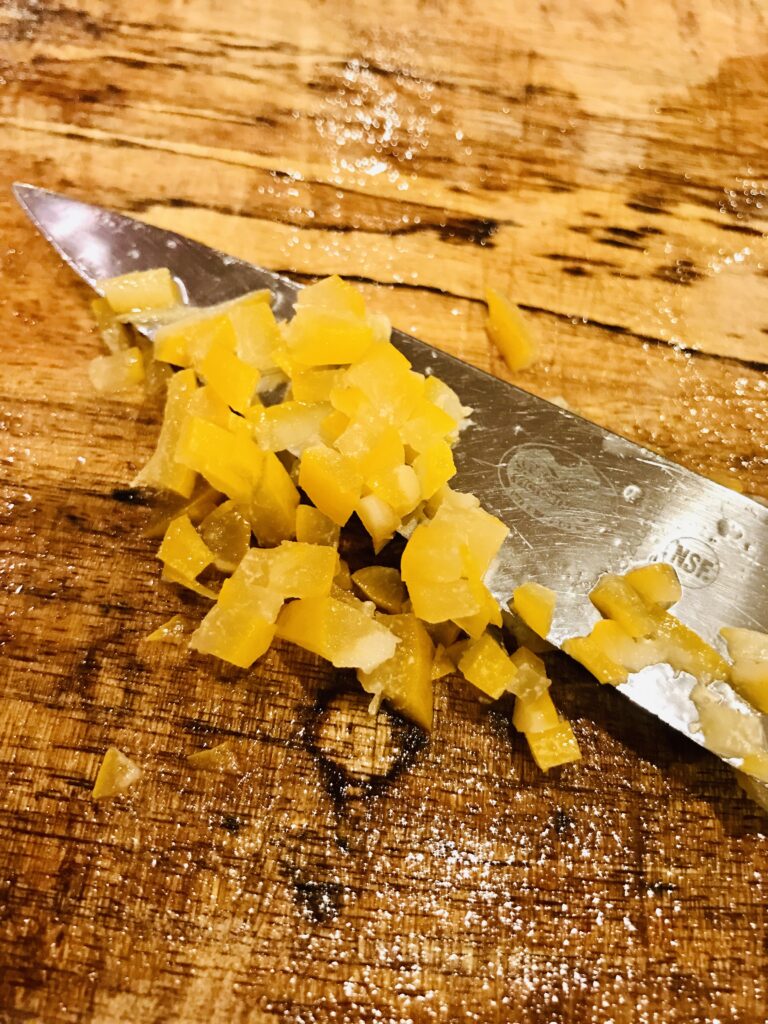When life gives you lemons…preserve them and use them all year long. Used in Moroccan cooking, Preserved Lemons add a pop of color, tangy saltiness, and depth to all your stews, dressings, and sauces.

Meyer Lemons

My mom lives in sunny California and she has the most beautiful lemon tree. I enjoy her care packages every December when the Meyer lemons are bursting off the bush. Meyer lemons are sweeter than regular lemons and their skins not as bitter. Consequently, this makes them the perfect candidate for preserving.
Winter Pop of Color
In the winter months, after all the Christmas decorations have been cleared, the home feels empty. Truthfully, I love the simplicity of our winter decor. The red has been removed and the colors become soothing and peaceful. Simple. Minimalistic. Quiet. After all the busyness of Christmas, my body is longing for simplicity, except for the occasional pop of lemon yellow. I LOVE lemon yellow in the winter months. Just having that one pop of color makes me feel alive and hopeful. Found in a bowl of lemons, lemon curd on a winter tea party table, a throw pillow, or a candle reminding me that spring is just around the corner, lemon yellow just brings Joy.
If life gives you Meyer lemons, preserve them. Make extra jars and give them as gifts. They are stunning preserved in jars. Additionally, they are loaded with vitamins, minerals, and gut-healthy probiotics. Don’t you just love how God gives us plants rich in vitamin C during a time when our bodies need that extra boost of nourishment to get through the winter months in health?

Recipe for Preserved Lemons
Okay, this might be a hard for all you detailed recipe followers. To start, it all depends on the size of your jar or number of lemons. One year, my mom sent me so many lemons, I made three quarts and gave them as gifts. Other times, I had a few extra lemons lying around so I made a quick pint jar. Preserving lemons uses more of a guideline than a recipe.
To start, all you need is a clean, sterilized jar with lid, Meyer lemons, a knife, salt, and a pounder. Depending on the size of your jar, gather your lemons and cut off the ends, careful not to cut into the juicy part. Then, cut each lemon in quarters, only slicing 3/4 of the way through so that it stays in tact at the bottom. In a bowl, individually take each lemon and fill with about 2 heaping teaspoons of Celtic or Himalayan sea salt and carefully place in the jar. Sprinkle an additional spoonful of salt over the lemons with each addition.
When all the lemons are placed in the jar, use a tamper or wooden spoon to pound the lemons down, releasing their juices. The lemons need to be fully submerged in the salty, lemony brine so mold does not develop. If there is not enough juice, add additional lemon juice. Feel free to place glass fermenting weights on top to submerge your lemons. This will ensure they stay under the brine.
Place the lid loosely on jar, or use a fermenting lid, cover with a flour sack towel, and place on the counter for 3-4 weeks to ferment. Check occasionally to make sure the lemons are fully submerged. If for any reason mold develops, discard. I have never had any problem, especially when using these fermenting lids.






Preserved Lemons Video
How Do I Use Preserved Lemons?
I am glad you asked. Honestly, I have to admit, the first time I made Preserved Lemons was only because I thought a jar filled with lemons would be beautiful in my refrigerator. I know what you are thinking…that is pathetic. Maybe. Or maybe I just really love and appreciate beauty and preserving these lemons was a way to connect with my mom all winter long.
Traditionally, preserved lemons are used in Moroccan cooking in tagine recipes, pilafs, stews, and sauces. It adds a depth of flavor to almost anything where you would use lemon zest.
Typically, you would use Meyer lemons in this recipe, but you can use regular lemons as well. Organic lemons are best, if possible, considering it is the skins you will be using in cooking. After fermentation, the insides are tossed because they are too salty, but the outer skins, are like lemon pickles…but not. You just have to trust me on this one. This will become one of your favorite must have condiments. Easy peasy lemon squeezy.




Shop This Post
Pickle Packer Fermentation Tamper you can just use a wood spoon
Fermenting lids– I have used wide-mouth quart sized jars with these fermenting lids as well as jars with clamp lids. If you use a jar with a clamp lid, you will need to burp them often. Fermenting causes natural gasses to form causing pressure to develop inside the jar. The fermenting lids allow for this pressure to be released while not exposing contents to bad bacteria.
Glass fermenting weights– Glass weights are wonderful for holding your ferments under the brine.
Flour Sack Towels– These are my favorite multi-use towels.
Wide-Mouth Gallon Glass Jar with Hinged Lid
24 oz Le Parfait clamp jar (these are my favorites for storing in the refrigerator afterwards) I use these for hot fudge sauce, caramel sauce, fermented jalapeños, pesto, and these beautiful lemons.
Pin For Later

In everything you do -eat, play, and, love- may it always be Seasoned with Joy!
This post contains affiliate links, which means I make a small commission at no extra cost to you. Unless stated otherwise, I will only recommend products I personally enJOY. See my full disclosure here.

oh, this was so fun to read and look at all the beautiful pictures! I will certainly have to try this recipe. Loved it… Lindy
Wow! I’m so proud of you! This is just so beautifully written! Our Meyer tree is so full this year! I’ve frozen whole lemons in the past but now I have a new option! Your love for beauty is inspiring❤️🍋
Wow they are beautiful and so tasty!